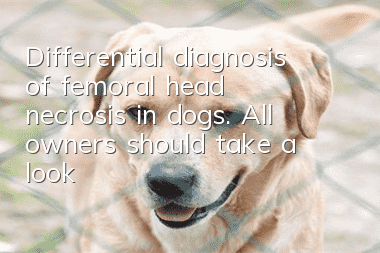Differential diagnosis of femoral head necrosis in dogs. All owners should take a look!

Introduction to femoral head necrosis in dogs
The main cause of femoral head necrosis in dogs is bone ischemia caused by obstruction of blood flow and damage to the femoral head, so it can also generally become avascular necrosis of the femoral head. Or aseptic necrosis of the femoral head. This type of disease has a high incidence rate in small dogs. Our common domestic pet dog, the Poodle, is one of the most frequently affected dog breeds.Diagnosis of cases of femoral head necrosis in dogs
The sick dog is a standard poodle. It was kept in good condition before the onset of the disease, with normal appetite and spirit. The dog food is mainly dog food. One month ago, it was discovered that the dog did not like to exercise. When he went out for a walk, he was unwilling to walk for a while. Seven days ago, he discovered that the dog's left hind limb was unwilling to touch the ground, was limping, and looked thinner than the other hind limb, and had symptoms of mild muscle atrophy.Examination and diagnosis of femoral head necrosis in dogs
1. Clinical examinationThe dog's body temperature is 38.5 degrees Celsius, heart rate is 75 beats/minute, breathing is 30 times/minute, the nose is moist, and the mental state is normal. The left hind limb was hanging, limping, and had obvious pain on palpation. The muscles were significantly thinner than those on the right side, accompanied by symptoms of mild muscle atrophy.
2. Laboratory examinationX-rays showed that the surface of the femoral head of the left hind limb was not smooth, the density of the posterior end of the metaphysis was inconsistent, the growth plate structure disappeared, and the femoral heads on both sides were asymmetrical. No abnormalities were found in routine blood tests and blood biochemical tests. Avascular necrosis of the femoral head can be diagnosed based on clinical symptoms and X-rays.
Surgical treatment for femoral head necrosis in dogs
After consultation with the pet owner, the decision was made to undergo surgical treatment. The affected dog lies on its side with the affected limb facing up. Atropine was injected subcutaneously, and 15 minutes later, anesthesia was induced with propofol, tracheal intubation, and isoflurane inhalation anesthesia. The surgical department is routinely shaved, disinfected, and isolated. In the anterolateral femoral incision, the tensor fascia latae and inter-biceps femoris fascia are cut, and the rectus femoris lateralis and rectus femoris are bluntly separated and pulled forward and backward to expose the hip joint capsule. Cut the hip joint capsule, cut off the round ligament, free the femoral head, separate the tissue on the femoral head as much as possible, make a hole at the base near the femoral end, insert a Kirschner wire, use an osteotome along the Kirschner wire to cut off the femoral neck, trim and grind The broken end is flattened, the joint capsule is closed, the muscles and subcutaneous fascia are sutured layer by layer, and the skin is sutured. Within 7 days after the operation, the affected limb was fixed with a suspension bandage, antibiotics were injected, and analgesics were taken. On the 7th day, the affected limb was able to touch the ground. From then on, the frequency of use of the affected limb was gradually increased every day. The owner massaged the muscles of the affected limb and stretched the affected limb. The sutures were removed on the 9th day and he was discharged from the hospital. He returned for a follow-up visit half a month later. He was in good condition and basically no longer limped.Summary of femoral head necrosis in dogs
1. Causes and pathogenesis of femoral head necrosis1) The main blood supply of the femoral head is the femoral head ligament artery, Capsular arteries and intramedullary nutrient arteries of the femoral neck. The above-mentioned vascular anatomical characteristics result in insufficient blood supply to the bone. Once other external influences cause vascular disease, it is easy to cause interruption of blood supply, local circulation disorder, and lead to avascular necrosis of the femoral head.
2) Traumatic necrosis of the femoral head. Femoral head blood supply disorder caused by various traumas, due to improper supplyThere is little collateral circulation in the region. When blood vessels are interrupted, avascular necrosis can occur. This situation is common in femoral neck fractures and hip dislocations. In some cases, when the femoral head is traumatized, although it is not enough to cause a fracture, it can cause blood supply disorders and lead to avascular necrosis of the femoral head;3) Non-traumatic avascular necrosis of the femoral head. There are various causes of non-traumatic avascular necrosis of the femoral head. Common causes include long-term use of hormones, connective tissue diseases, blood diseases and fat embolism, which can all induce necrosis of the femoral head. Its pathogenesis is not yet fully understood.
2. As the understanding of the disease deepens, it is found that the disease may be related to trauma, transient synovitis, abnormal growth and development, endocrine disorders, autoimmune deficiencies, genetics, environment and other factors. However, its exact etiology and pathogenesis are not yet fully understood. Most of the currently recognized breeds are small dogs, such as Poodles, Deer Dogs, Cairns, West Highland White Terriers, Manchester Terriers (detailed), Yorkshire Terriers, Chihuahuas, etc. A large amount of clinical data shows that the incidence rate of male dogs and female dogs is similar, generally between 3 and 13 months of age, and more frequently at 6 to 7 months of age. 10%-17% of dogs have bilateral disease. When visiting the hospital, the course of the disease had exceeded 2 weeks, and in some cases even exceeded 1 month. For the treatment of avascular necrosis of the femoral head in dogs, the most common and effective method is resection of the femoral head and neck to relieve pain. After functional exercise, a false joint is formed and the weight-bearing function is restored. The application of drug conservative therapy can only relieve pain, but it is difficult to improve its function. Surgical treatment should be performed as soon as possible, otherwise it will cause muscle atrophy and be very harmful to postoperative functional exercises. The most important thing after surgery is to bear weight as soon as possible and carry out functional rehabilitation exercises as soon as possible. The earlier you exercise, the better your recovery will be. If there is disease on both sides of the femoral head, the femoral head and one side of the neck should be removed first. After 30-45 days, the other party should be finished.
3. If the symptoms of the dog are not very serious or the dog cannot undergo surgical treatment due to its own physical reasons, conservative treatment can be adopted, that is, taking analgesics to relieve the dog's pain and conducting appropriate swimming training. However, conservative treatments can usually only temporarily relieve symptoms. When the dog's physical condition is suitable, surgical treatment must be proactively removed to remove the root cause of the disease.- Dog has dandruff and scabs on his body
- How long does it take for a dog’s beard to grow back after being cut?
- Dog panting suddenly becomes heavy in winter
- The most obvious signs of prepartum in dogs
- The difference between fox and dog
- Can French cattle be raised as native dogs?
- Can Bichons eat chestnuts?
- Is it normal for Bichon Frize puppies to have yellow hair?
- What should I do if my dog’s placenta is not expelled?
- Why are there so few springer dogs?



